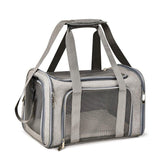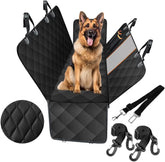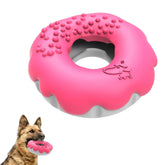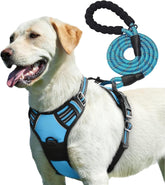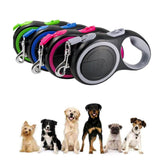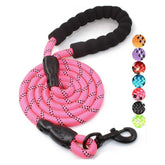Ever been chased by your pet dog? The pet parents would always say yes to that question. They are always on the run around the house just to follow their owner. They take a whole house tour from room to room to kitchen to bathroom, right? Still, it does feel cute and adorable. But with time, if you see your dog on perpetual run behind you, you cannot help but ponder, "Why does my dog follow me everywhere?"
The answer is simple. Yes, this habit does reflect devotion and loyalty, but beneath all that, it can be a sign of difficulties such as separation anxiety, being bored, or seeking reassurance.
Here in this blog, you will find the most prevalent causes of how dogs become your shadows and guide you on what to do about such behavior.
Top 5 Reasons Why Dogs Follow You Around
Ever find yourself thinking, "Why is my dog following me everywhere suddenly?" This trait can be cute, but also confusing. So, why do your dogs trail behind you everywhere? Let's discuss the top five reasons behind this popular dog behavior.
1. They Love You and Feel Safe Around You
Ever find yourself thinking, "Why is my dog shadowing me around everywhere lately?" You're not alone. Lots of pet parents observe their dogs becoming mini shadows, stuck to them from one room to the next. The behavior can be endearing, yet it can also be confusing. So, why do dogs follow you everywhere? Let's dive into the top five reasons why this is a common canine habit.
2. They’re Hoping for Food, Treats, or Attention
If your pup has figured out that you're the source of all things good—like treats, belly rubs, and fun—chances are they’ll stick to you like glue. Why? Because in their eyes, following you = rewards. This is what’s known as a conditioned response. Over time, if tending to you around the house keeps getting them love or snacks, it just becomes a habit. Basically, they’re not clingy—they’re just really good at playing the odds!
3. It’s in Their Nature — Instinctive Pack Behavior
Dogs are descendants of pack animals and have an instinctual drive to stick with their group—or in this case, you. In a domestic setting, you're their leader, and their natural pack mentality kicks in. That means staying close, observing your cues, and sticking by your side. This instinctual behavior is especially strong in the companion animal or breed known for being extra clingy.
4. They’re Bored or Looking for Mental Stimulation
At other times, the cause is very simple—your dog is simply bored. Dogs, particularly energetic breeds, require physical and mental enrichment in order to remain in equilibrium. If left unstimulated, they will begin following you around just for something to do. It's their way of searching for activity or perhaps hoping for a chance to play, explore, or meet their stimulation needs.
5. They’re Trying to Communicate Something
This type of behavior can also be used as a means of dog communication. Perhaps your dog must go outside to the bathroom, is ill, or is anxious. You can identify the signs of discomfort and needs through canine body language. Maybe they are trying to tell you something about their condition and want you to understand their signaling needs.
How to Help Your Dog Become Less Clingy
Through the proper dog training and everyday routine, you can positively coax your puppy to be independent but still strong in its bond.
Here are some effective, vet- and trainer-approved tips to manage and reduce obsessive behavior in dogs:
1. Teach Commands Like “Stay” and “Place”
Basic obedience training goes a long way in setting boundaries. Teaching commands like “stay” and “place” helps your dog understand that it’s okay (and even rewarding) to stay put in a certain area while you move around. Practice with short sessions, reward calm behavior, and slowly increase the distance and duration to build their confidence.
2. Create Structured Alone-Time Daily
Start by giving your dog short periods of alone time every day. You can use a baby gate or keep them in a safe, comfy room with toys and treats. This structured routine following, helps reduce dependence and prevents your dog from feeling anxious the moment you leave the room. Gradually increase this time as they get more comfortable.
3. Use Interactive Toys or Puzzle Feeders
If your dog is following you everywhere all day long, they could very well be bored out of their minds. Try giving them something to do instead—interactive dog toys for boredom like snuffle mats or puzzle feeders can keep them engaged and mentally stimulated.
4. Don't Give Attention Every Time They Follow
It's natural to pet or speak to your dog every time they follow behind you, but this can reward the behavior. Instead, delay attention. Reward them only when they're calm or engaged in some activity on their own. This shows them being near doesn't always equal being petted, and ends the cycle of persistent attachment.
5. Encourage Calm Behavior With Treats When They're Independent
Catch your dog not following you around? Perfect time to reward them! Just the right moment to reward them! Reward them with treats, words of praise, or a favorite toy for independent behavior.
Dog Breeds That Tend to Follow You the Most
Ever wondered why do dogs follow you around, with some breeds being more attached than others? Although individual personality and environment contribute a great deal, some breeds are bred to be genetically glued to the side of their owner. These Velcro dog breeds are bred for companionship, work, or protection, which naturally extends their loyalty and attachment.
Let’s look at a few breeds that are famously clingy and affectionate:
1. Labrador Retriever
Labs are famous for being loving, friendly and loyal dog breeds. Originally bred as hunt companions and service dogs, they live on the interaction with humans. Their endless desire to be engaged makes them one of the most prevalent Velcro dog breeds.
2. Border Collie
Clever and lively, Border Collies are emotionally bonded with their human companions. Born to work directly alongside shepherds, they're accustomed to keeping pace with the handler's every step. That drive continues at home, where they frequently follow their preferred person around.
3. German Shepherd
They generally have traits of being protective, obedient, and fiercely loyal. They have an instinctive desire to take on the role of "shadow," staying by your side to serve and protect.
4. Vizsla
Commonly referred to as the "Velcro Vizsla", this is one of the most human-focused breeds around. Vizslas don't simply like your companionship—they need it. They're most content when they're in contact or leaning against you, even if you're simply hanging out around the house.
5. Cocker Spaniel
Cocker Spaniels are very affectionate breeds and eager to please. Considered a sensitive dog breed, they often get too attached and build a strong bond with their owner. This can lead to clinginess, but can be balanced by training for independence.
6. French Bulldog
Small and snuggly, Frenchies are social dogs to the core. They tend to become emotionally attached and trail after their owners from room to room, just because they enjoy being close to you.
7. Golden Retriever
One of the most in-demand breeds for families. They are among the most loyal family dogs and empathetic. Since they are very active, whether it's playing fetch or sitting with you while you work. They develop a deep bond with the owner.
If your dog is a breed that we've mentioned, and you are consistently fielding the question of, "Why does my dog follow me everywhere?"—here's the truth: it's partly in their genes. Their dedication is certainly flattering, yet it also says something about their needing a dose of independence training to feel self-assured when you're gone.
When Your Dog’s Behavior Might Need Professional Help
It’s cute when your dog wants to be around you all the time, but if they’re suddenly following you everywhere, it could be more than just love.
It’s important to know when to reach out for professional help to make sure your dog stays happy and healthy.
When Your Dog Turns into Your Shadow
There could be times when dogs can't seem to leave your side, even during their sleep time. This could be really adorable, but that also shows that your dog is all dependent on your presence and might be anxious at night.
They Go To Destruction Mode When You Leave
Ever come home to find your shoes torn or your cushions shredded? It's not badness—it happen due to separation anxiety in dogs. Your dog's way of telling you, "I missed you so much, I didn't know what to do without you."
Making sounds constantly
Dogs have a habit of making noises, like barking, whining, or starting to pace around the house. But, if it happens when you're just about to leave home. Then maybe they need guidance on how to be calm when you are not around.
Not Wanting to Eat or Acting Strange
If your dog suddenly stops eating, changes their sleeping patterns, or just acts "off," there is more to it than clinginess. There might be something going on, either mentally or physically.
So, When Should You Worry?
If any of this sounds familiar and it’s happening often, it’s worth talking to your vet. They’ll check if anything’s going on health-wise. You can also reach out to a dog trainer or behaviorist who can help with separation anxiety in puppies or adult dogs to make them feel more confident and okay with being on their own sometimes.
Conclusion
It's completely adorable when your dog just wants to be with you all the time – their loyalty and affection are truly some of the highlights of pet ownership. But just as with any relationship, there must be some room.
While it may be adorable at first when they're always following you around, it can get a little much if it becomes an all-the-time thing. It could be an indicator that something's amiss, such as worry, boredom, or even emotional stress.
